5 min read
7 Asset Management Trends Shaping the Industry in 2025

On this page
On this page
On this page
On this page
The asset management industry is undergoing a profound transformation driven by technological innovation, shifting investor preferences, and evolving market dynamics. To thrive in this new environment, firms must understand the latest trends for strategic positioning and future growth.
Here are seven crucial asset management trends shaping the industry—and how asset managers can take action in 2025.
1. Software Is Eating the Asset Management World
From portfolio construction to investor engagement, software is and will continue to reshape the future of the asset management industry. Inspired by Marc Andreessen’s now-famous insight, “software is eating the world,” we see the same dynamic playing out across financial services.
Indexes: The dramatic shift from active to passive management represents the codification of investment strategies into rules-based algorithms.
Model portfolios: Investment decisions are increasingly being systematized through model-based approaches that can efficiently scale.
Robo-advisors: Automated platforms continue to gain market share and expand access to low-cost financial advice.
Direct indexing: Once exclusive to ultra-high-net-worth individuals, personalized indexing strategies are now accessible to a broader audience through technological advancements.
AI integration: Firms are integrating artificial intelligence into investment processes, including security selection, risk management, and client service.
What can asset managers do?
Invest in digital infrastructure that supports personalization at scale and streamlines operations. Explore how generative AI and machine learning can sharpen investment strategies, enhance client experiences, and improve distribution efficiency.
2. The Industry Is Consolidating
Market share is increasingly concentrated among the largest players. As of December 2024, the top 25 asset managers control a growing share of fund assets—creating new economies of scale and pressure on margins.
This consolidation further drives fee compression, with both asset-weighted and equal-weighted average fees continuing their steady decline for both passive and active strategies.
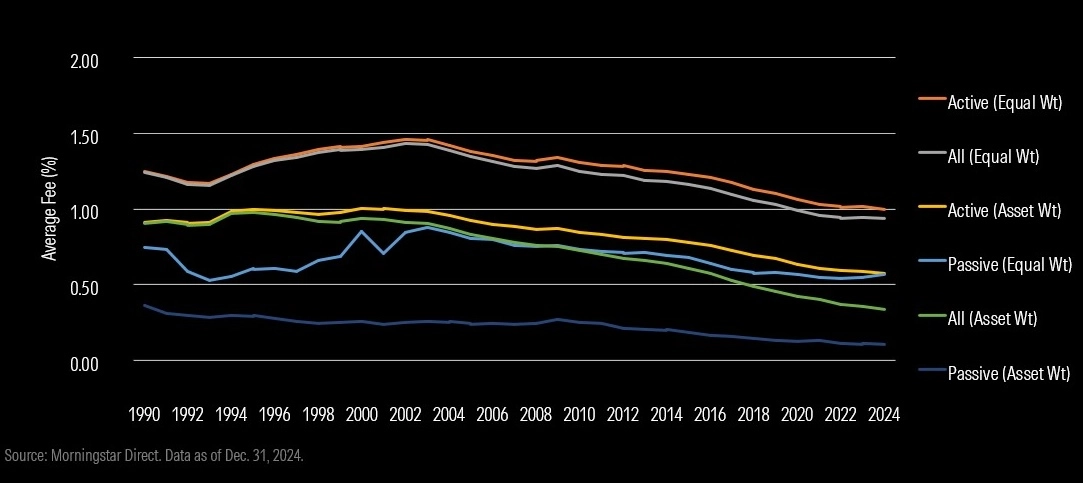
Average fund fees have steadily declined from 1990 to 2024, with passive funds experiencing the most significant drop compared to active funds.
What can asset managers do? Mid-sized and smaller firms should lean into their unique value proposition and competitive edge, whether it’s niche expertise, product innovation, or exceptional client service. Larger firms should prioritize leveraging scale to improve efficiency and expanding capabilities through strategic acquisitions. Regardless of size, all firms should regularly evaluate their pricing models to remain competitive and sustainable.
3. The Post-Mutual Fund Era
Traditional mutual funds continue to lose market share as investors and plan sponsors gravitate toward lower-cost, tax-efficient, and more flexible vehicles.
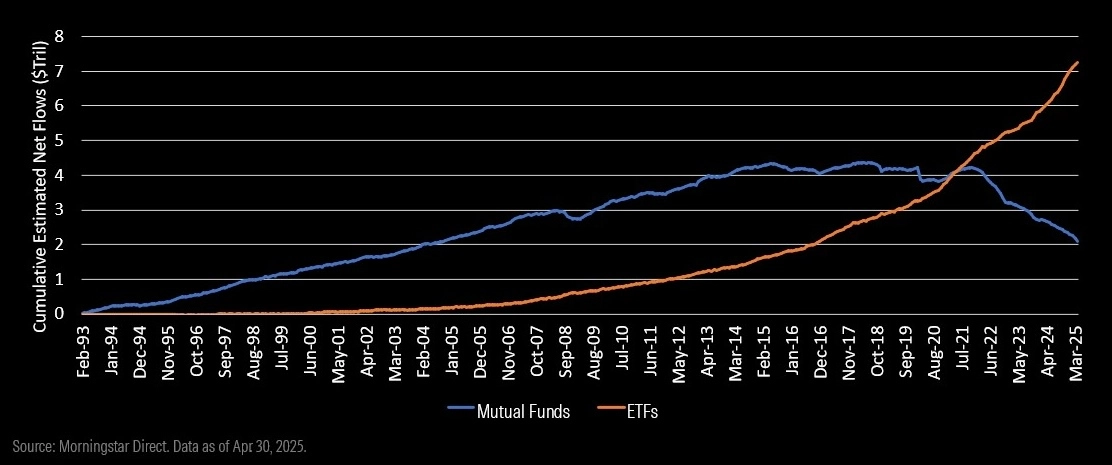
Cumulative fund flows since 1993 show ETFs steadily gaining assets and surpassing mutual funds around 2021, while mutual fund flows have declined sharply in recent years.
- ETFs as the preferred vehicle: ETFs have firmly established themselves as investors' preferred wrapper, with cumulative flows exceeding those of mutual funds.
CITs on the rise: Collective investment trusts are gaining traction, particularly in retirement plans, as they offer lower costs and greater flexibility than mutual funds.
Fund conversions are increasing: Asset managers are responding by converting mutual fund strategies into ETFs or launching new ones directly to meet investor preferences.
What can asset managers do? Diversify product offerings to meet investor demand in vehicles, such as ETFs and CITs. Evaluate whether your mutual fund strategies are good candidates for conversion or repositioning and ensure the transition approach preserves existing client relationships while embracing modern vehicle preferences.
4. Active Management Is Being Redefined
Despite the dominance of passive investing, active management is undergoing an evolution.
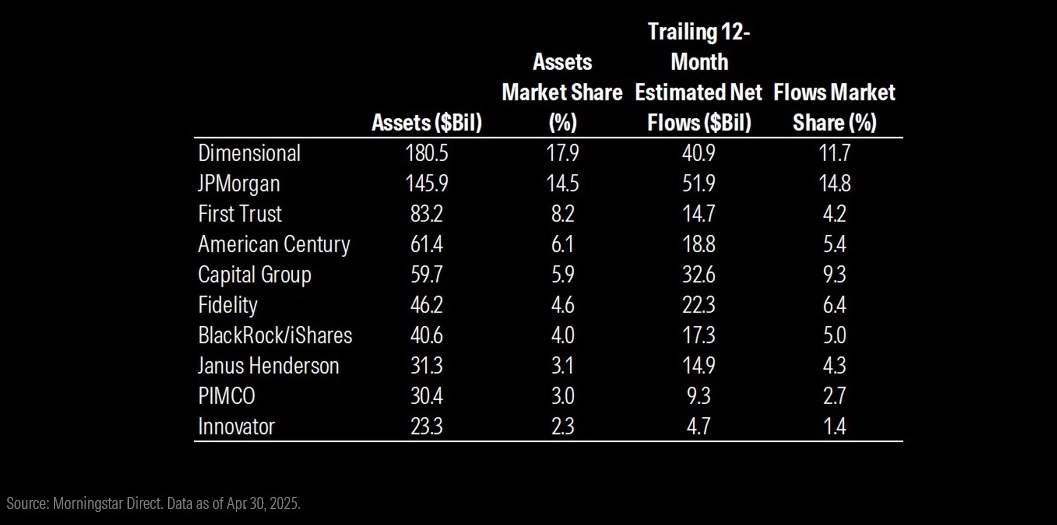
Top asset managers by ETF assets and flows as of April 2025, with JPMorgan leading in net inflows and Dimensional holding the largest asset share.
- Active ETFs gaining momentum: Active ETFs represent one of the fastest-growing segments of the market, making up 86% of total ETF launches in early 2025.
Active ETF market share growing: Active ETFs now account for a substantial portion of ETF flows, though assets remain concentrated among top providers.
“Active” is a spectrum: From systematic equity approaches to options income and defined outcome products, the range of active styles continues to expand.
What can asset managers do? Identify opportunities to embrace active strategies that can justify active fees. Consider how your active strategies can be integrated into the investment process without compromising performance. Educate clients and advisors about the evolving nature of active management and the benefits it can bring.
5. Low Risk Return Is Back—With Political and Policy Risk Following
The return of meaningful yield has revived investor interest in fixed income. But the higher-rate environment also brings new risks, especially those tied to monetary and fiscal policy.
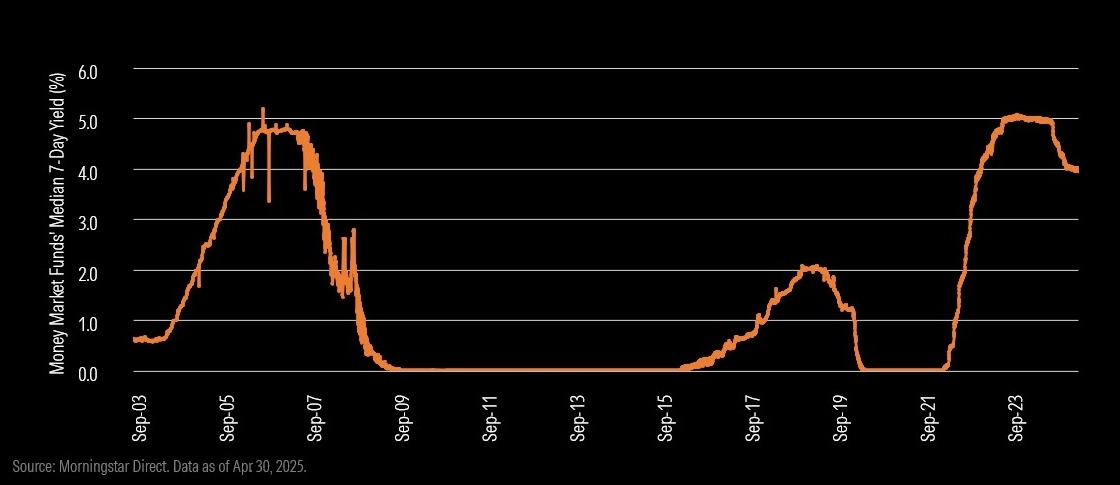
Money market fund yields are still up.
- Money market yields remain elevated: Money market fund yields have stabilized at much higher levels than the previous decade, and flows have followed.
Bond strategies are seeing renewed demand: Fixed-income products have experienced renewed interest as investors seek yield with relatively lower risk compared to equities.
Policy uncertainty is rising: Fiscal spending, trade dynamics, and interest rate path uncertainty are back on the radar.
What can asset managers do? Develop innovative fixed-income solutions that capitalize on the current rate environment. Consider launching or emphasizing short-duration and flexible bond strategies that address rate and credit risks. Help clients understand the role of bonds in portfolio diversification and how political decisions could affect those allocations.
6. Thematic Investing Follows a Boom-Bust Pattern
Investor enthusiasm for thematic strategies tends to rise and fall quickly—2025 is no exception.
Volatile flows: Thematic funds have experienced fluctuations in investor sentiment, characterized by periods of strong inflows followed by substantial outflows.
Performance chasing persists: Investor behavior continues to exhibit classic performance-chasing patterns, frequently resulting in buying high and selling low and poor timing decisions.
- New launches are slowing: To meet the weaker demand, asset managers are moderating the pace of thematic fund.
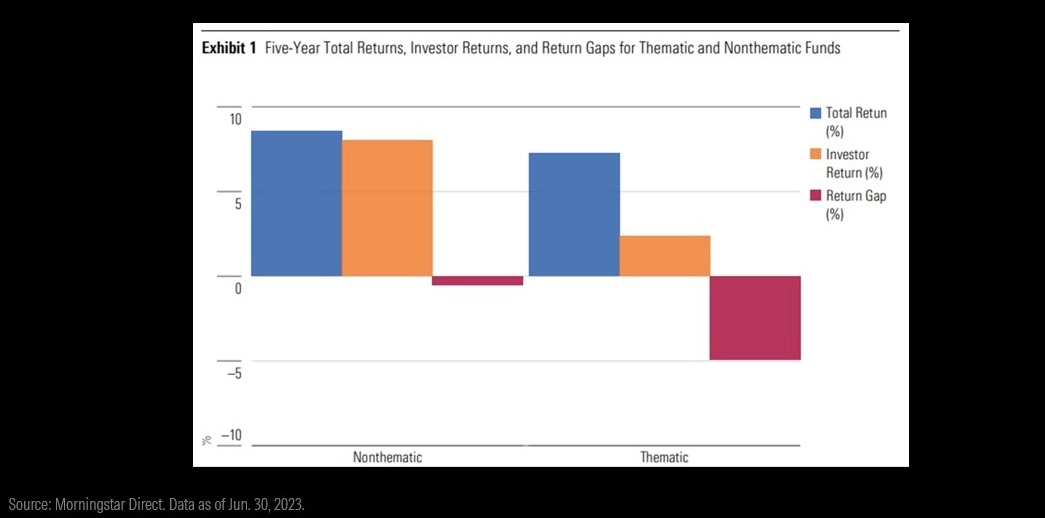
Investor sentiment for thematic and nonthematic funds have risen and fallen quickly with strong inflows and outflows.
What can asset managers do? Approach thematic strategies with caution and discipline. Rather than chasing the latest “hot” theme, develop thematic products with long-term structural drivers and clear investment theses.
7. The Alternative Investment Landscape Is Expanding
Investor interest in alternatives continues to grow, especially with the new vehicle structures making it more accessible.
Options-based strategies booming: Defined outcome and derivative income strategies are gaining inflows as investors seek downside protection and enhanced yield.
Interval funds gaining traction: The number of interval funds has grown steadily, offering semiliquid access to alternative strategies that were previously available only to institutional investors.
Private market demand remains strong: Despite slower fundraising, private equity and credit remain core to many long-term portfolios.
What can asset managers do? Develop alternative strategies that can scale through accessible vehicles, such as interval funds and ETFs. Focus on educating clients about the role of alternatives in portfolio construction, particularly when offering semiliquid or complex strategies.
Position Your Firm for Success: Preparing for the Future of Asset Management
As 2025 unfolds, successful asset management firms will be those that embrace asset management technology trends, adapt to changing vehicle preferences, and deliver compelling investment solutions aligned with evolving investor needs. The future of the asset management industry presents both challenges and opportunities for firms willing to embrace change.
Morningstar Direct is here to help. The comprehensive platform gives asset managers the much-needed tools to construct diversified portfolios, analyze asset management trends with the latest fund flow data, and build sustainable products that line up with client values—all backed by our trusted data.